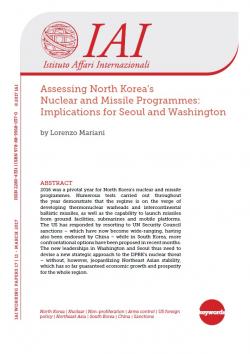Assessing North Korea's Nuclear and Missile Programmes: Implications for Seoul and Washington
2016 was a pivotal year for North Korea’s nuclear and missile programmes. Numerous tests carried out throughout the year demonstrate that the regime is on the verge of developing thermonuclear warheads and intercontinental ballistic missiles, as well as the capability to launch missiles from ground facilities, submarines and mobile platforms. The US has responded by resorting to UN Security Council sanctions – which have now become wide-ranging, having also been endorsed by China – while in South Korea, more confrontational options have been proposed in recent months. The new leaderships in Washington and Seoul thus need to devise a new strategic approach to the DPRK’s nuclear threat – without, however, jeopardizing Northeast Asian stability, which has so far guaranteed economic growth and prosperity for the whole region.
Paper prepared in the framework of the reasearch project “Trust Building in North East Asia and the Role of the EU”, promoted by the Istituto Affari Internazionali (IAI) with the kind support of the Korea Foundation (KF).
-
Details
Roma, IAI, March 2017, 18 p. -
Issue
17|11 -
ISBN/ISSN/DOI:
978-88-9368-037-0
Introduction
1. The Byungjin policy and its strategic success
2. The growing nuclear threat
3. The missile programme
3.1 Hwasong-6
3.2 Nodong
3.3 Musudan
3.4 Taepodong
3.5 Pukkuksong-1
4. What options for South Korea and the United States?
Conclusion
References
Topic
Tag
Related content
-
Ricerca22/03/2016
Trust-building in North East Asia and the role of the EU
leggi tutto



